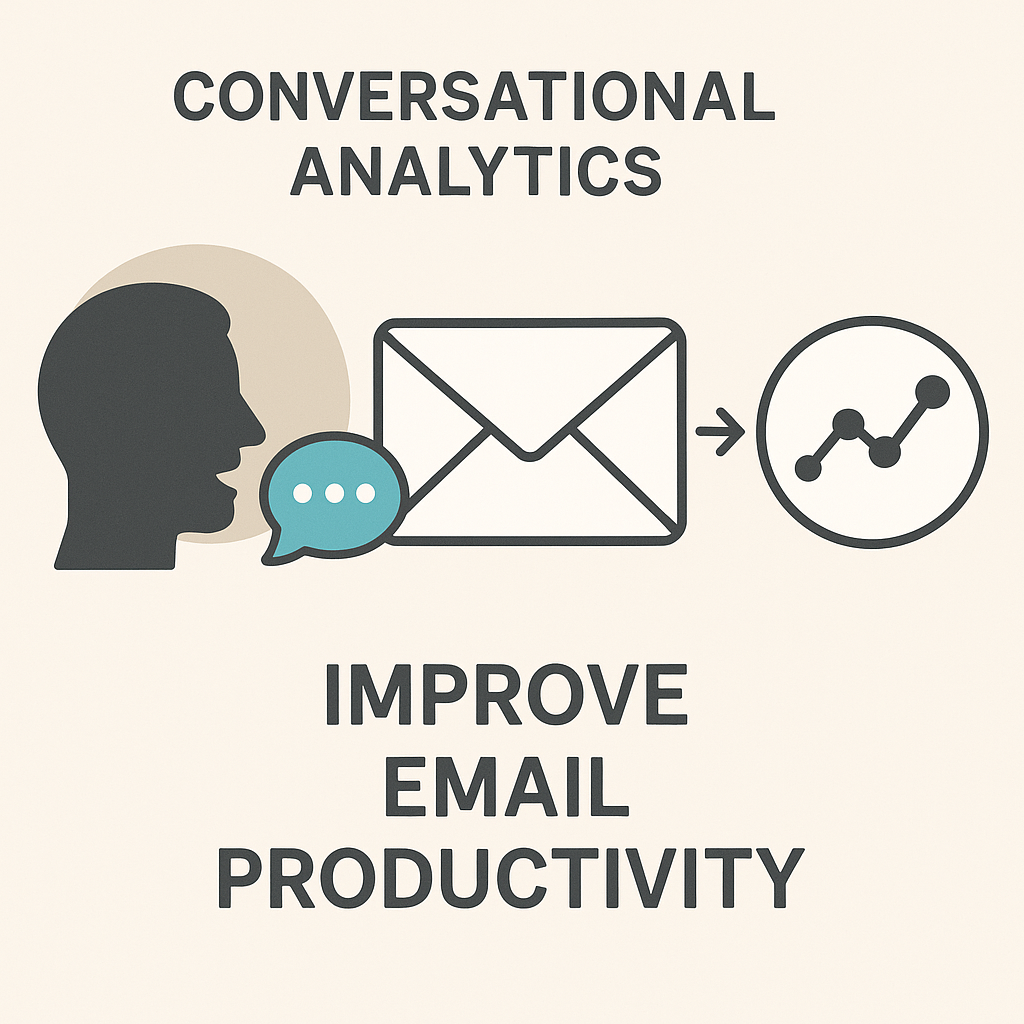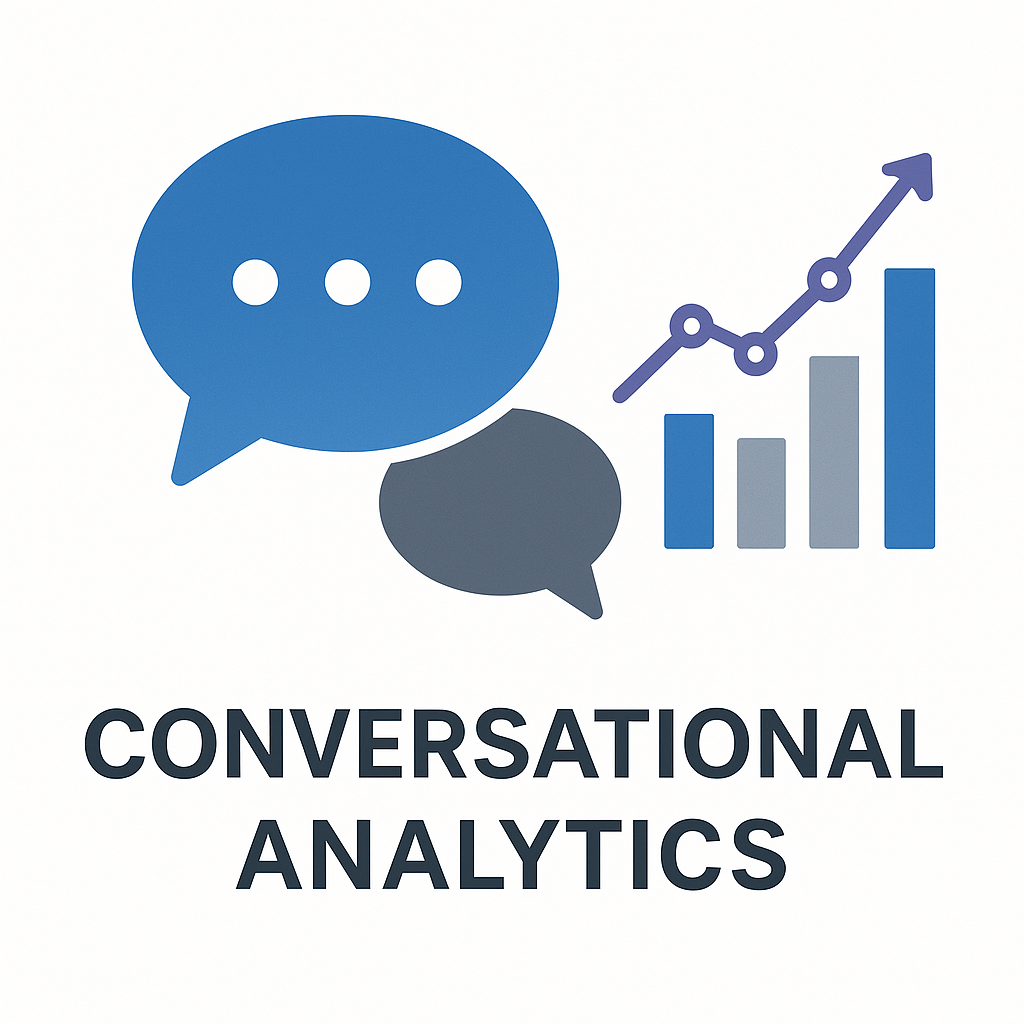Conversational Analytics: Supercharge Your Email Productivity

The constant ping of new emails. The endless scroll. For professionals, entrepreneurs, and teams, the inbox often feels like a battlefield, a relentless tide of communication that demands constant attention. In today's fast-paced business world, managing this deluge efficiently is critical, yet often feels like an insurmountable challenge. But what if you could do more than just manage your emails? What if you could truly understand them, extracting valuable intelligence and transforming them into a powerful engine for growth and productivity? This is precisely where conversational analytics steps in, offering a revolutionary approach to email management and business email analysis. By harnessing the power of Artificial Intelligence (AI), it provides deep insights into customer sentiment, identifies emerging trends, and streamlines communication, ultimately supercharging your email productivity tools and enhancing your AI communication capabilities.
The Pain Points: Overcoming Inbox Overload with AI Insights
We're all familiar with the pain points of modern email: the sheer volume, the time spent sifting through messages, the struggle to prioritize, and the constant fear of missing something crucial. The average professional spends a significant portion of their day—often 2-3 hours—just managing their inbox. This isn't just inefficient; it's a major drain on mental energy and a substantial bottleneck for business progress. When your inbox management is reactive rather than proactive, the consequences can be severe:
- Missed Opportunities: Key client requests or sales leads can get buried under less urgent messages.
- Delayed Responses: Frustrating wait times for clients or colleagues can damage relationships.
- Lost Information: Important details, action items, or decisions can be overlooked in lengthy threads.
- Reduced Productivity: Valuable time that could be spent on strategic tasks is consumed by administrative email handling.
- Inconsistent Communication: Without clear insights, maintaining a consistent and effective communication tone across a team can be difficult.
This overwhelming reality highlights the urgent need for smarter, AI-driven solutions. Conversational analytics offers a powerful way to cut through the noise, identify what truly matters, and reclaim your time and focus. It transforms your email from a source of stress into a strategic asset.
How Conversational Analytics Works in Email: Key Features Explained
At its core, conversational analytics is the process of analyzing human interactions—in this case, your email exchanges—to extract actionable insights. It's like giving your email communications a sophisticated brain that can comprehend context, discern tone, and understand intent. This is achieved through advanced AI technologies, primarily:
- Natural Language Processing (NLP): This branch of AI enables computers to understand, interpret, and manipulate human language. In email analysis, NLP can identify entities (names, dates, locations), extract key topics, understand the relationships between words, and even detect the nuances of language.
- Machine Learning (ML): ML algorithms learn from data patterns. By analyzing vast amounts of email correspondence, ML models can identify recurring themes, predict customer behavior, classify sentiment, and improve their analytical accuracy over time.
These technologies work together to meticulously process the text within your emails. Unlike basic keyword searches, conversational analytics dives deeper, analyzing the structure of conversations, the sentiment expressed, and the underlying intent of the communicators. It goes beyond simply reading the words to understanding the meaning and implications behind them, providing a comprehensive layer of business email analysis.
For a deeper understanding of the concept, resources like RingCentral's guide on Conversational Analytics offer a solid foundation, explaining how it analyzes interactions across various channels to provide actionable insights.
Unlocking Deeper Insights: Sentiment Analysis, Trend Identification, and More
The true power of conversational analytics in email lies in the depth of insights it can uncover. It moves beyond surface-level data to reveal critical information that can inform strategy and improve communication:
Customer Sentiment Analysis
One of the most impactful applications is customer sentiment analysis. AI algorithms can detect the emotional tone within emails. Are your clients expressing happiness, frustration, confusion, or enthusiasm? By identifying sentiment markers, you can:
- Proactively address negative feedback before it escalates.
- Identify happy customers who might be open to testimonials or referrals.
- Gauge the overall mood of your client base or specific segments.
- Tailor your communication style to match the recipient's emotional state, fostering better rapport.
Understanding sentiment is crucial for building strong, lasting relationships and managing brand perception effectively.
Trend Identification
Beyond individual messages, conversational analytics excels at identifying overarching trends within your communications. Imagine being able to instantly see:
- Recurring questions or common pain points raised by multiple clients.
- Emerging issues or bugs reported by users.
- Frequently requested features or improvements.
- Patterns in successful sales conversations versus those that stall.
Pinpointing these trends allows for strategic business improvements, from refining product development and enhancing customer support processes to optimizing sales scripts and marketing messages. These are invaluable email insights that drive informed decision-making.
Key Information Extraction
Manually sifting through long email threads to find critical pieces of information is time-consuming. AI can automatically extract:
- Action items and assignees.
- Key deadlines and dates.
- Contact information and company details.
- Important decisions and agreements.
This ensures that vital data is never lost and can be easily tracked, managed, and acted upon, significantly improving efficiency.
As detailed by Hashe's Complete Guide to Conversational Analytics, this process is fundamental to understanding customer behavior and preferences derived from their direct communications.
Boosting Productivity: Automating Responses and Streamlining Workflows
The most direct benefit of integrating conversational analytics into your email workflow is a significant boost in productivity. AI-powered tools can automate repetitive tasks and streamline complex processes, freeing up valuable human capital for more strategic work.
Email Automation
Leveraging AI for email automation can transform how your team handles routine communications. This includes:
- Automated Responses: Drafting replies to frequently asked questions (FAQs) about pricing, shipping, support hours, or product specifications.
- Smart Categorization: Automatically sorting incoming emails into relevant folders (e.g., Sales Leads, Support Tickets, Invoices, Internal Memos) for easier management.
- Intelligent Prioritization: Flagging urgent messages based on keywords, sender importance, or detected sentiment, ensuring critical emails are addressed first.
- Follow-up Reminders: Automatically scheduling follow-up tasks based on conversation content or agreed-upon timelines.
These capabilities drastically reduce the time spent on administrative tasks, allowing professionals to focus on higher-value interactions.
Streamlining Workflows
Beyond simple automation, conversational analytics can streamline complex workflows by:
- Summarizing Long Threads: Providing concise summaries of lengthy email conversations, allowing recipients to quickly grasp the main points and decisions without reading every message.
- Identifying Action Items: Highlighting tasks and deadlines mentioned within emails, ensuring nothing falls through the cracks.
- Facilitating Collaboration: Making it easier for team members to share relevant email context or insights with each other.
Tools designed to enhance inbox management and improve overall efficiency are key. For instance, exploring AI workflow solutions can help integrate these intelligent processes seamlessly.
Personalization at Scale: Enhancing Customer and Client Relationships
In today's competitive landscape, generic communication simply doesn't cut it. Customers and clients expect personalized interactions that acknowledge their history, preferences, and specific needs. Conversational analytics makes hyper-personalization achievable at scale.
By analyzing past email interactions, AI can provide a detailed understanding of:
- Individual customer preferences and communication styles.
- Specific pain points or challenges they've previously raised.
- Key interests or needs expressed in their own words.
- Their journey and engagement level with your brand.
This deep insight allows you to tailor your messaging, offers, and support with unprecedented accuracy. When you can reference previous conversations, address specific concerns mentioned in prior emails, and adapt your tone accordingly, you build stronger, more trusting relationships. This enhanced AI communication fosters loyalty, increases customer satisfaction, and can significantly improve conversion rates.
For small businesses looking to make a big impact, understanding these nuances can be a game-changer. Applying principles from email marketing tips for small businesses, personalization powered by analytics ensures your outreach is always relevant and resonant.
Real-World Applications: Examples for Sales, Marketing, and Management
The versatility of conversational analytics means it can benefit virtually every department within an organization. Here are a few examples:
For Sales Teams
Sales professionals can leverage these insights to:
- Identify Buying Signals: Detect keywords and sentiment that indicate a prospect is ready to buy or move to the next stage.
- Understand Objections: Analyze how prospects articulate their concerns, allowing for more effective counter-arguments.
- Gauge Deal Health: Monitor the sentiment and engagement levels in ongoing deal discussions to predict outcomes.
- Personalize Outreach: Craft follow-up messages that directly address points raised in previous email exchanges.
This leads to more efficient sales cycles and higher closing rates.
For Marketing Teams
Marketers can use conversational analytics to:
- Analyze Campaign Feedback: Understand customer reactions to marketing campaigns directly from email responses and inquiries.
- Identify Content Gaps: Discover what information customers are consistently seeking that isn't readily available.
- Refine Messaging: Use the language customers use to describe their problems and needs to create more compelling marketing copy.
- Segment Audiences: Group customers based on their expressed interests or challenges for more targeted campaigns.
As noted by Iovox, conversational or speech analytics (which extends to text) is about gathering and reporting actionable insights from customer conversations.
For Management and Leadership
Managers and executives can gain valuable oversight:
- Monitor Client Satisfaction: Track sentiment trends across key accounts to identify potential churn risks or opportunities for upselling.
- Assess Team Performance: Analyze communication patterns within teams to identify areas for training or process improvement in AI communication.
- Strategic Decision-Making: Use aggregated insights from customer emails to inform business strategy, product roadmaps, and operational adjustments.
- Executive Efficiency: Quickly grasp the essence of complex email discussions, making informed decisions faster. This is crucial for effective executive email management.
These tools provide objective data to support leadership decisions and improve overall business operations.
Integrating Conversational Analytics with Your Email Workflow (and MailToPie)
Integrating conversational analytics into your daily workflow doesn't have to be an overwhelming undertaking. It's about adopting the right tools and mindset to leverage the data already present in your communications.
Choosing the Right Tools
Start by identifying your biggest pain points in inbox management. Are you drowning in repetitive questions? Struggling to track action items? Looking to understand customer sentiment better? Then, look for AI email solutions that directly address these challenges. Consider platforms that offer features like:
- Automated email summarization.
- Intelligent sentiment tracking.
- Smart response suggestions and drafting.
- Automated categorization and prioritization.
- Keyword and topic trend analysis.
These tools are designed to augment your capabilities, not replace the human touch where it's most valuable. For professionals seeking to truly supercharge their email management, leveraging advanced AI tools is becoming a necessity. Platforms that offer an ai executive assistant can help streamline your workflow by analyzing inbound and outbound correspondence, suggesting replies, and flagging critical tasks, freeing up valuable time. These intelligent systems provide the power of business email analysis and AI communication directly within your existing email client, making inbox management more efficient than ever. This is a key aspect of modern AI workflow solutions, akin to having a dedicated admin virtual assistant for your digital communications. You might also find value in exploring other smart ways to manage your inbox, such as focusing on managing Gmail more effectively, as many advanced solutions integrate these powerful analytical capabilities.
Implementation and Best Practices
When adopting these technologies, consider the following:
- Start Small: Begin with a pilot program or a specific team to test and refine the integration process.
- Data Privacy and Security: Ensure any tool you choose complies with relevant data protection regulations (e.g., GDPR, CCPA) and has robust security measures in place.
- Training: Properly train your team on how to use the new tools and interpret the insights they provide.
- Integration with Existing Systems: Look for solutions that can integrate smoothly with your CRM, project management tools, or other business software for a unified workflow.
By thoughtfully integrating these AI-powered capabilities, you can unlock a new level of efficiency and insight.
As highlighted by Surveypal, conversational analytics offers significant benefits by providing valuable insights and streamlining processes across various communication channels.
Conclusion
Conversational analytics represents a significant leap forward in how we manage and leverage email. It transforms your inbox from a chaotic repository of messages into a rich source of actionable intelligence. By applying AI for sophisticated business email analysis, you can move beyond the daily struggle of inbox management to gain profound email insights, enhance AI communication, and drive tangible business results.
The benefits are clear and compelling: improved customer sentiment analysis, the ability to identify critical business trends, powerful email automation capabilities, and the power to personalize customer interactions at scale. Ultimately, embracing conversational analytics leads to increased productivity, stronger client relationships, and a significant competitive edge in today's dynamic marketplace.
Don't let your valuable email correspondence go unanalyzed. Embrace the future of communication by exploring how conversational analytics and intelligent AI tools, such as an ai executive assistant, can transform your workflow and supercharge your business outcomes. Start analyzing your conversations today and discover the hidden potential waiting within your inbox.
```


